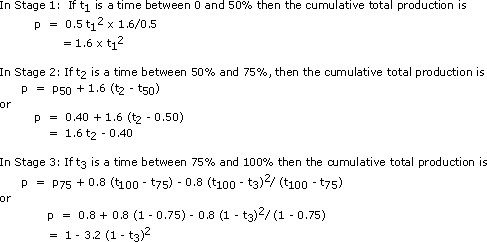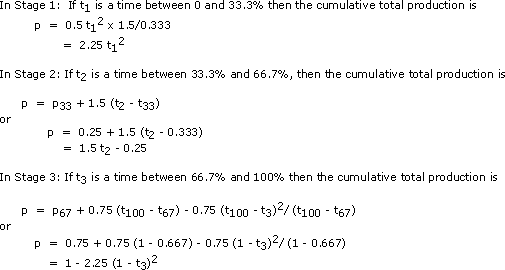Appendix 1
Definitions and Formulae adopted in this paper
Production (Rate)
The rate at which units are produced over a given period of time, independent
of the number of man-hours consumed.
Productivity
In its broadest form, productivity may be described as a measure of how well
the resources in a firm are brought together and used to accomplish a set of
results.[7] In its simplest form, it may
be expressed as the ratio of output to input or the actual rate of output or
production per unit of time worked.[8]
These represent measures of production efficiency. When measurements are taken
over a given period of time, the period productive efficiency is the number of
units produced in that time period divided by the number of man-hours to do so.
S-curve
When the cumulative total of on-going work on a construction job is plotted
against time, the resulting curve typically follows the shape of the letter "S".
It is more generally referred to as a Progress Curve.
Learning or Experience Curves
Studies have shown that the change in cost associated with a change in productivity
has, in many situations, a characteristic curve that can be estimated with reasonable
accuracy. This is called the "learning curve" or "experience
curve".[9]
The underlying phenomenon is that skill and productivity in performing tasks
improve with experience and practice and there are a number of different ways
of plotting this relationship that facilitate mathematical analysis. Two models
of Learning Curves are given in Appendix 2, Learning Curve Mathematics.
Well-run
A well-run construction job implies that adequate and realistic planning has
taken place and a positive cultural environment has been established for the
performance of the work on site. It also means that supporting logistics, including
delivery of materials and equipment, have been properly assessed and will be
provided when needed to enable optimized crew sizes to maximize their production
at least cost at each point in time. It follows that the resulting project should
be perceived as successful in terms of meeting requirements and being completed
within credible time and cost parameters. For an owner this would mean that the
resulting facility has satisfied the stipulated needs, within reasonable time
and budget. For a contractor, it would mean satisfying the owner at a profit.
In contrast, actual progress on a not-so-well-run job will depart from the
plan or proceed as "a voyage of discovery". The records will likely
reflect wasted manpower before sufficient work is available or after it is substantially
completed, lower productivity, higher manpower turnover, additional learning
costs, added supervision, labour and non-labour-related job expenses and overhead,
added material storage, handling and wastage, and extended completion.
Standard Resource Input curve (SRI S-curve)
Points on the SRI S-curve may be determined as follows:

Standard Production Output curve (SPO S-curve)
Points on the SPO S-curve may be determined as follows:

7. Cleland,
D. I. 1990. Project Management Strategic Design and Implementation. TAB Books
Inc. Blue Ridge Summit, Pennsylvania. 344.
8. Cleland, D. I. and Kerzner H. 1985. A Project Management dictionary of
Terms. Van Nostrand Reinhold C. New York. 193.
9. Anthony, R. N. and Reece, J. S. 1975. Management Accounting: Text and Cases.Richard D. Irwin, Inc., Homewood, Illinois. 540.
|



